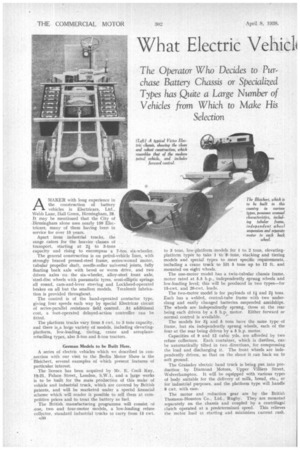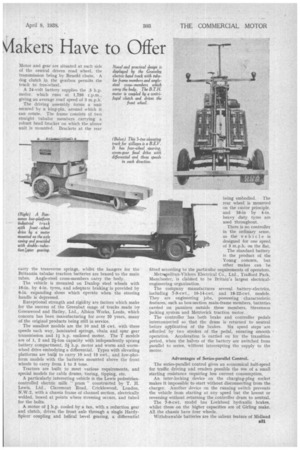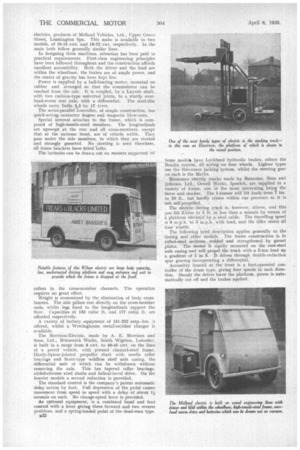What Electric Vehict Vlakers Have to Offer
Page 64

Page 65

Page 66

Page 67

If you've noticed an error in this article please click here to report it so we can fix it.
AMAKER with long experience in the construction of battery vehicles is Electricars, Ltd., Webb Lane, Hall Green, Birmingham, 28, It may be mentioned that the City of
Birmingham alone uses nearly 150 EIectricars, many of them having been in service for over 15 years.
Apart from industrial trucks, the range caters for the heavier classes of transport, starting at 2+ to 3-tons capacity and rising to encompass a 7-ton six-wheeler.
The general construction is on petrol-vehicle lines, with strongly braced pressed-steel frame, series-wound motor, tubular propeller shaft, needle-roller universal joints, fully floating back axle with bevel or worm drive, and two driven axles on the six-wheeler, alloy-steel front axle, 'steel-disc wheels with pneumatic tyres, semi-elliptic springs all round, cam-and-lever steering and Lockheed-operated brakes on all but the smallest models. Tecalemit lubrication is provided throughout.
The control is of the hand-operated contactor type, giving four speeds each way by special Electricar circuit of series-parallel resistance field control. At additional cost, a foot-operated delayed-action controller can be fitted.
The platform trucks vary from 5 cwt. to 3 tons capacity, and there is,a large variety of models, including elevatingplatform, low-loading, tiering, crane and aeroplanerefuelling types, also 3-ton and 5-ton tractors.
German Models to be Built Here.
A series of electric vehicles which we described in connection with our visit to the Berlin Motor Show is the ""Bleichert, several examples of which present features of particular, interest The licence has been acquired by Mr. E. Cecil Kny, 19-21, Palace Street, London, S.W.1, and a large works is to be built for the mass production of this make of vehicle and industrial truck, which are covered by British patents, and will be marketed under a special financial scheme which will render it possible to sell them at competitive prices and to treat the battery as fuel.
The British manufacturing programme will consist of one, two and four-motor models, a low-loading refuse collector, standard industrial trucks to carry from 15 cwt. a30 to 3 tons, low-platform models for 1 to 2 tons, elevatingplatform types to take 1 to 8 tons, stacking and tiering models and special types to meet specific requirements, including a crane truck to lift 5 tons up to 12 ft. and mounted on eight wheels, The one-motor model has a twin-tubular chassis frame, motor rated at 5.5 h.p., independently sprung wheels and low-loading level; this will be produced in two types—for I5-cwt. and 20-cwt. loads.
The two-motor model is for payloads of 1+ and 2+ tons. Each has a welded, central-tube frame with two underslung and easily changed batteries suspended amidships. The wheels are independently sprung, those at the rear being each driven by a 5 h.p; motor. Either forward or normal control is available.
The models for 34. and 5 tons have the same type of frame, but six independently sprung wheels, each of the four at the rear being driven by a 5 h.p. motor.
Capacities of 9 and 12 cubic yds. are afforded by two refuse collectors. Each container, which is dustless, can • be automatically tilted in two directions, for compressing the load and discharging it, The front wheels are independently driven, so that on the shoot it can back on to soft ground.
The Graiseley electric hand truck is being put into production by Diamond Motors, Upper Villiers Street, Wolverhampton. It will be equipped with various types of body suitable for the delivery of milk, bread, etc., or for industrial purposes, and the platform type will handle 8 cwt. with ease.
The motor and reduction gear are by the British Thomson-Houston Co., Ltd., Rugby. They are mounted separately on the chassis and coupled by a centrifugal clutch operated at a predetermined speed. This relieves the nactor load at starting and minimizes current rush. carry the transverse springs, whilst the hangers for the Britannia tubular traction batteries are brazed to the main tubes. Angle-steel cross-members carry the body.
The vehicle is mounted on Dunlop steel wheels with 16-in. by 4-in. tyres, and adequate braking is provided by 6-in, expanding shoes which operate when the steering handle is depressed.
Exceptional strength and rigidity are factors which make for the success of the Greenbat range of trucks made by Greenwood and Batley, Ltd., Albion Works, Leeds, which concern has been manufacturing for over 20 years, many of the original products being still in service.
The smallest models are the 10 and 15 cwt. with three speeds each way, laminated springs, chain and spur gear transmission and 14 h.p. enclosed motor. The T models are of 1, 2 and 24-ton capacity with independently sprung battery compartment, 24 h.p. motor and worm and wormwheel drive embodying a differential. Types with elevating platforms are built to carry 10 and 15 cwt., and low-platform models with the batteries mounted above the front wheels to carry from 1 to 3 tons.
Tractors are built to meet various requirements, and special models for cable drums, tiering, tipping, etc.
A particularly interesting vehicle is the Lewis pedestrian. controlled electric milk " pram " constructed by T. H. Lewis, Ltd., Claremont Road, Cricklewood, London, N.W.2, with a chassis frame of channel section, electrically welded, boxed at points where stressing occurs, and tubed for the bolts.
A motor of 4 h.p. cooled by a fan, with a reduction gear and clutch, drives the front axle through a single Hardy. Spicer coupling and helical bevel gearing, a differential being embodied. The rear wheel is mounted on the castor principle, and 16-in by 4-in. heavy duty tyres are used throughout.
There is no controller in the ordinary sense, as the vehicle is designed for one speed of 3 m.p.h. on the flat.
The standard battery is the product of the Young concern, but other makes can be fitted according to the particular requirements of operators.
IVIetrispolitan-Vickers Electrical Co., Ltd., Trafford Park, Manchester, is claimed to be Britain's largest electricalengineering organization.
The company manufactures several battery-electrics, including 7-9-cwt., 10-14-cwt. and 18-22-cwt. models. They are engineering jobs, possessing characteristic features, such as box-section main-frame members, batteries carried on panniers outside these members, Stevenson jacking system and Metibvick traction motor.
The controller has both brake and controller pedals interconnected so that the drum is returned to neutral before application of the brakes. Six speed steps are afforded by two strokes of the pedal, ensuring smooth , operation. Acceleration is carried on for the transition period, when the halves of the battery are switched from parallel to series, 'Without interrupting the supply to the motor.
Advantages of Series-parallel Control.
The series-parallel control gives an economical half-speed for traffic driving and renders possible the use of a small starting resistance requiring less current consumption.
An inter-locking device on the charging-plug socket makes it impossible to start without disconnecting from the charger. Another device on the running switch prevents the vehicle from starting at any speed but the lowest or reversing without returning the controller drum to neutral.
The 7-9-cwt. model has Lockheed hydraulic brakes, whilst those on the higher capacities are of Girling make. Al the chassis have four Ns-heels.
Withdrawable batteries are the salient feature of Midland 881 eIeetrics, products of Midland Vehicles, Ltd., Upper Grove Street, Leamington Spa. This make is available in two models, of 10-15 cwt. and 18-22 cwt. respectively. In the main both follow generally similar lines.
In designing these machines, attention has been paid eo practical requirements. First-class engineering principles have been followed throughout and the construction affords excellent accessibility. Both the driver and the load are within the wheelbase, the brakes are of ample power, and the centre of gravity has been kept low.
Power is supplied by a ball-bearing motor, mounted on rubber and arranged so that the commutator can be reached from the cab. It is coupled, by a Layrub shaft, with two cushion-type universal joints, to a sturdy overhead-worm rear axle, with a differential. The steel-disc wheels carry India 545 by 17 tyres.
The series-parallel controller, of simple construction, has quick-acting oontactor fingers and magnetic blow-outs.
Special interest attaches to the frame, which is composed of high-tensile-steel members. The longitudinals are upswept at the rear and all cross-members, except that at the extreme front, are of vehicle width. They pass under the side members, to which they are riveted and strongly gusseted. No riveting is used elsewhere, all frame brackets have fitted bolts.
The batteries can be drawn out on runners supported bY rollers in the cross-member channels. The operation requires no great effort.
Weight is economized by the elimination of body crossbearers. The side pillars rest directly on the cross-member ends, whilst legs fixed to the longitudinals support the floor. Capacities of 183 cubic ft_ and 177 cubic ft. are afforded respectively.
A variety of battery equipment of 161-252 amp.-hrs. :s offered, whilst a Westinghouse metal-rectifier charger is available.
The Morrison-Electric, made by A. E. Morrison and Sons, Ltd., Brunswick Works, South Wigston, Leicester, is built in a range from 8 cwt. to 40-45 cwt. on the lines of a petrol vehicle, with pressed channel-steel frame, Ilardy-Spieer-jointed propeller shaft with needle roller hearings and Scott-type weldless steel axle casing, the differential wait of which can be withdrawn without removing the axle. This has tapered roller bearings, nickel-chrome steel shafts and helical-bevel drive. On the heavier models a second reduction is provided.
The standard control is the company's patent automatic delay action by foot. Pull depression of the pedal causes movement from speed to speed with a delay of about 1 seconds on each. No change-speed lever is provided.
As optional equipment, is a combined hand and foot control with a lever giving three forward and two reverse positions, and a spring-loaded pedal of the dead-man type. 1332
Some mode*. have Lockheed hydraulic brakes, others the Ben-dix system, all acting on four wheels. Lighter types use• the Stavenson jacking system, whilst the steering gear en.eich is the Marles.
• Rinsonws .electric treks made by Ransonie, Sims and jeffeetes; Ltd., Orwell Works, Ipswich, are supplied in a variety of forms, one of the most interesting being the
• tierer and stacker. • The 1-tonser will lift loads from 7 ins. to 10 ft., but hardly comes within our province as it is not self-propelled.
The electric ;tiering truck is, however, driven, and this can lift 2:teins to 5 ft. in less than a minute by means of a platform elevated by a steel cable. The travelling speed is 4 m.p.h. to 5 m.p.h. with load, and the tiller steers all
four Wheels. . . • . .
• The following brief description applies generally to the tiering and other Models. The frame construction is in rolled-steel legions, „welded and strengthened by gusset plates. The motor is rigidly mounted on the cast-steel axle casing and will propel the truck with a 2-ton load up a gradient of 1 in 5. It drives through double-reduction spur gearing incorporating a differential. Accessibly housed at the front is a feot-.operated controller of the drum type, giving four speeds in each direction. Should the driver leave the platform, power is automatically cut off and the brakes applied. steel box on the upswept sprung part of the frame carries the battery.
Trailing wheels and axles vary with the different types, whilst fixed or swivel axles to suit twoor four-wheel steering can be provided.
An auxiliary pedal allows coasting when running downhill, thus economizing in current.
The Slingsby-Automatic tricks and tractors, marketed by II. C. Slingsby, 89, 95 and 97, Kingsway, London,. W.C.2, can operate in confined spaces. In the main, they are based upon automobile design. In the lighter types, transmission is by silent chain, but in the heavier, worm drive is utilized. Ample power permits fully loaded trucks to negotiate gradients of 1 in 10.
The control pedal can be used only when the operator is in the correct position. In repose, it interrupts the current and applies a powerful brake.
The trucks vary in capacity from 10 cwt. to 2 tons, whilst there are tiering models, a tractor to haul 8 tons to 12 tons, and another, with three wheels, for 3 tons.
The Sunbeam electric, made by Sunbeam Commercial Vehicles, Ltd., Mootheld Works, Wolverhampton, has electrical equipment constructed by the British ThomsonHouston Co., Ltd., which also supplies all electric traction equipment for Sunbeam-3.T.11, trolleybuses.
The contactor system of control is similar to that which has proved so satisfactory on those trolleybuses for many years. There is one pedal for the controller and another for the four-wheel brakes, leaving the hands free for steering, etc.
The battery is carried in three sections, two at the sides of the chassis and the third between the chassis members, behind the back axle.
Two sizes are builtfor 12,-15-cwt. loads. The standard model has a platform space of 7 ft. 11i ins, behind the cab, and the long cha-ssis, 9 ft. The latter is intended for bodies of reasonably large cubic capacity, but the wheelbase is the same on each.
• Straightforward design is' displayed in the Victor Electric made by Victor Electrics, Ltd., Burscough Bridge, Ormskirk, Lancashire. Several types are available varying from a trivan of 8..cwt, to a 3-ton Mx-wheeler-and 5-ton tractor, also a mechanical horse.
' These vehicles are the outcome of 15 years' development 'carried on prior to 1933, which resulted in the production of the Tow front-entrance vehicle and low-rate charger. The latter has added much interest to this make, as the simple charger can be sent out with each vehicle, hung on a nearby wall, and plugged into an A.C. socket.
The ideal of .20 years' life and freedom from major repairs (so far as the chassis is concerned) has been aimed at, and it is claimed that some of the first Victor 1-ton eleetrics made can still do a week's work for about 21, including interest, depreciation, repairs, power and battery renewals.
It will be seen from the illustration that the large single motor drives through a tubular propeller shaft to a banjotype axle mounted on semi-elliptic springs shackled at the rear-The channel frame is of quite massive construction, and the batteries are suspended from lighter channels carried right across the side members.
Wilson-Electrics, made by Partridge, Wilson and Co., Ltd., Davenset Works, Evington Valley Road, Leicester, are well known, being in the hands of some of the largest users, such as the Corporations of Brighton, Wakefield, Bolton, West Ham, Hong Kong, etc., also by bakers, dairymen, etc. The capacities range from 5 cwt. to 20-25 cwt.
Representative of the smaller models is the LW., with a low, unobstructed driving platform and easy entrance and exit. The speeds are selected either by finger-light controls or, on the A.L.W., B.L.W. and C.L.W. models, by a foot accelerator operating the Wilson fluid automatic controller, Exide-Ironclad traction-type batteries are fitted as standard, and are hung between the chassis members in cradles immediately under the platform, being easily accessible through floor traps. The pressed-steel frame of the chassis is dropped at the front, and provided with tubular and channel-section cross-members.
Transmission from the single motor is by tubular propeller shaft with Hardy Spicer joints. Bendit brakes operate on all four wheels, and thp 10-in, steering wheel has a Marles-Weller steering gear. The springs. both front and rear, are of the semi-elliptic type in silico-manganese steel; those at the back have friction-type shock absorbers.
In the ampere-hour meter, a red hand indicates when the exhausted condition is being approached. At the " full" position, contacts operate in connection with a cut-out on the Davenset charger, isolating the charging plant from the battery and switching off the main supply.
Where vehicles are called upon to operate in abnormally hilly districts a special reduction gear can be provided at a moderate cost.
With the fluid controller, complete depression of a pedal allows relay contacts to close in rotation at a rate governed by a dashpot. Pedal release cuts off power, providing dead-man" control. Meanwhile, the fluid checking unit returns to the " off " position 'ready for the next depression of the pedal.
A variety of industrial trucks is made by Wingrove and Rogers, Ltd., Polar Works, Old Swan, Liverpool. All are arranged to be driven in either direction, a safety switch interlocked with the controller and brake pedal ensuring " fool-proof " control. The pedal must be depressed before the circuit is made, the same action releasing the brakes, and the controller must be brought to neutral before starting. The removal of a cartridge fuse prevents unauthorized use.
The models vary from straightforward platform trucks to carry 10 cwt. to 3 tons ; three and four-wheeled tractors for 5 to 10 tons, and elevating trucks of 1to 5-tons capacity. A popular type is for carrying, stacking and loading, made in 1-ton and 2-ton capacities and lifting 5 ft. and ft, respectively. Then there are crane trucks and special models for cable drums, hospital beds, etc.






















































































































